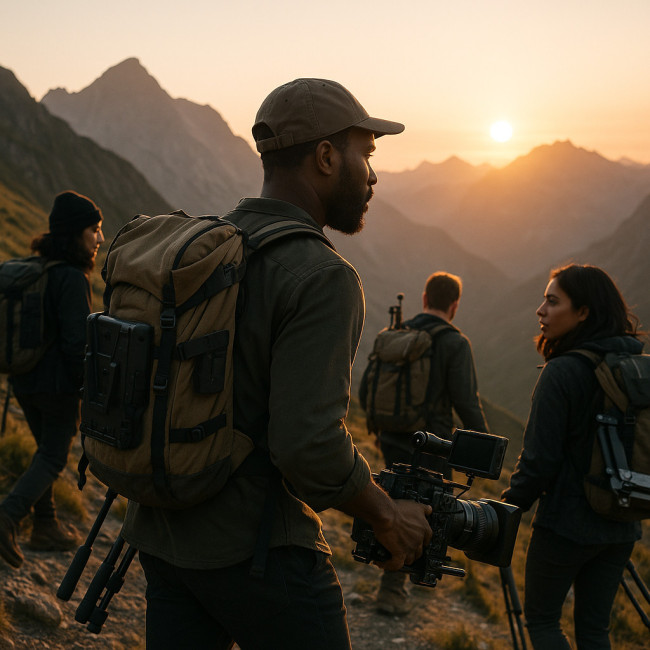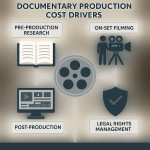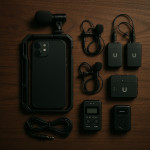Field-ready gear lists for documentary crews filming in remote locations
Filming a documentary miles from the closest power socket or camera shop demands meticulous gear planning. This guide delivers proven, field-tested equipment lists, pack-light strategies, and budgeting tips so your crew captures every critical moment—without costly reshoots or emergency shipments.
1. Core camera bodies and lenses
The backbone of any field kit is a dependable camera that balances image quality, battery efficiency and ruggedness.
Recommended camera bodies
- Sony FX6 – full-frame sensor, dual native ISO, 0.89 kg body only.
- Canon EOS R5 – 45 MP stills, 8K video, 0.65 kg.
- Blackmagic Pocket Cinema 6K Pro – internal ND, 13 stops of dynamic range, 1.24 kg.
Essential lenses for versatility
- 24-70 mm f/2.8 – interview framing & b-roll.
- 70-200 mm f/4 – discreet wildlife or distant action.
- 14-24 mm f/2.8 – cramped interiors, establishing shots.
Opt for lightweight zooms where possible to reduce the number of primes you carry. When you must hike for hours, shaving even 500 g makes a remarkable difference.
2. Power management: batteries & solar
Remote trips often fail because of dead batteries, not broken cameras.
- High-capacity V-Mount batteries (98 Wh) – allowed on most airlines yet power an FX6 for 3–4 hours.
- USB-C PD power banks (20 000–26 800 mAh) for mirrorless bodies and laptops.
- Foldable 100 W solar panel paired with an MPPT charge controller.
- 12 V regulated cable to run recorders or wireless links directly from the V-Mount.
Rule of thumb: plan 150 Wh per shoot day per camera. Adjust upward in sub-zero climates where battery efficiency drops 20–30 %.
3. Audio kit that survives sand, rain and altitude
| Scenario | Primary Mic | Backup | Wind Protection |
|---|---|---|---|
| Sit-down interviews | Sennheiser MKH-50 | RØDE Lavalier II | Full blimp + dead cat |
| Run-and-gun | Deity S-Mic 2S | Tascam DR-10L recorder-lav combo | Foam + fur slip-on |
| Ambience beds | Zoom H3-VR | Zoom F6 stereo pair | Micover cyclone |
Pair the mics with a 32-bit float recorder such as the Zoom F6; its dual AD converters virtually eliminate clipping, giving you peace of mind when sound checks are impossible.
4. Stabilisation: tripods, gimbals & mounts
- Sachtler Ace XL tripod (1.82 kg) – 8 kg payload for cinema bodies.
- Gitzo carbon monopod – quick direction changes in dense crowds.
- DJI RS 3 Mini – 795 g, ideal for mirrorless rigs under 2 kg.
- Ultralight suction mounts & magic arms for vehicle interiors.
5. Drones & aerials (comply before you fly)
The DJI Mavic 3 Pro (0.96 kg) offers 10-bit D-Log, 45-minute flights and omnidirectional sensing, making it the current sweet spot for pack size versus cinematic quality. Always file permits well ahead of departure; local authorities in remote regions may take longer to process UAV paperwork.
6. Data wrangling & redundancy
Field backup workflow
- Copy card to SSD #1 (editing drive).
- Clone SSD #1 to rugged HDD #2 (parity).
- Checksum verify both copies.
- Ship HDD #2 with departing crew member if internet is unavailable.
Laptops with dual Thunderbolt 4 ports like the MacBook Air M2 handle two SSDs on bus power, saving one extra charger.
7. Personal survival & comfort items
Your documentary cannot finish if the crew falls sick.
- Electrolyte tablets to combat dehydration.
- Layered merino basewear – dries overnight, reduces smell.
- Compact water filter pump & chemical backup tablets.
- Headlamp with 300-lumen flood and 5 lumen red mode.
- Basic med kit plus altitude pills when shooting above 3 000 m.
8. Sample 10-day kit: weight & priorities
Source : Manufacturers' spec sheets
This snapshot shows the tripod outweighing most electronics. If your total pack limit is 20 kg, consider swapping to a monopod or renting larger support locally.
9. Budgeting smarter
Gear weight is tangible, but cost creeps up silently. Cross-check your list with the realistic documentary budget benchmarks to avoid overspending on redundant accessories. For eco-minded productions, consult our guide to sustainable gear choices that cut costs.
10. Risk mitigation & insurance must-haves
From crushed lenses in jeep rides to stolen drones at border crossings, risk follows every kilometre. Pack:
- Pelican case with TrekPak dividers for air & river transport.
- Global gear insurance covering theft, accidental damage, and loss in transit.
- Printed carnets listing serial numbers to speed customs clearance.
For a deeper dive into contingency planning, read our article on live-shoot risk management.
11. Crew roles & communication equipment
Even with a three-person skeleton crew, clear roles save time and battery.
| Role | Primary Task | Comms Gear |
|---|---|---|
| Director-DP | Shot list, storytelling | Full-duplex comms headset |
| Camera assistant | Focus, media swap | Walkie with boom mic |
| Sound op | Mic placement, monitoring | IFB in-ear monitor |
12. Remote location scouting
Use lightweight drones or satellite maps to pre-plan camera positions. Our resource on scouting documentary storytellers online also explains how to evaluate local fixers who can secure access and interpreters.
Quick Quiz: Are you field-ready?
FAQ
- How do I choose between mirrorless and cinema bodies for a trek documentary?
- Evaluate weight, power draw, and codec flexibility. Mirrorless wins on grams; cinema bodies excel in onboard audio and ND filters.
- What's the safest way to ship footage from the field?
- Use rugged HDDs with checksum verification, then send a duplicate with a departing crew member or via bonded courier.
- Can I rely solely on solar charging?
- Yes, with 100 W panels and clear weather, but always carry at least two fully charged V-Mounts as a rainy-day buffer.
- Do I need drone insurance for every country?
- Laws vary, but most regions now require third-party liability coverage before approving flight permits.
- Where can I find vetted documentary videographers when local hire is required?
- Visit the curated documentary videographer directory to filter by region, language and gear compatibility.
Next steps

Lock your gear list, cross-check weight and budget, then rehearse load-out drills until every crew member packs blindfolded. If you optimise gear now, you'll land in the edit suite with footage that sings—rather than excuses. For additional post-production efficiency, see how to turn one shoot into five deliverables. Practice timed gear checks so everyone knows where each item lives, reducing setup time in unpredictable weather and ensuring critical batteries and media never get left behind.
Ready to roll? Bookmark this checklist, share it with your producer, and step into your next remote shoot with total confidence.











